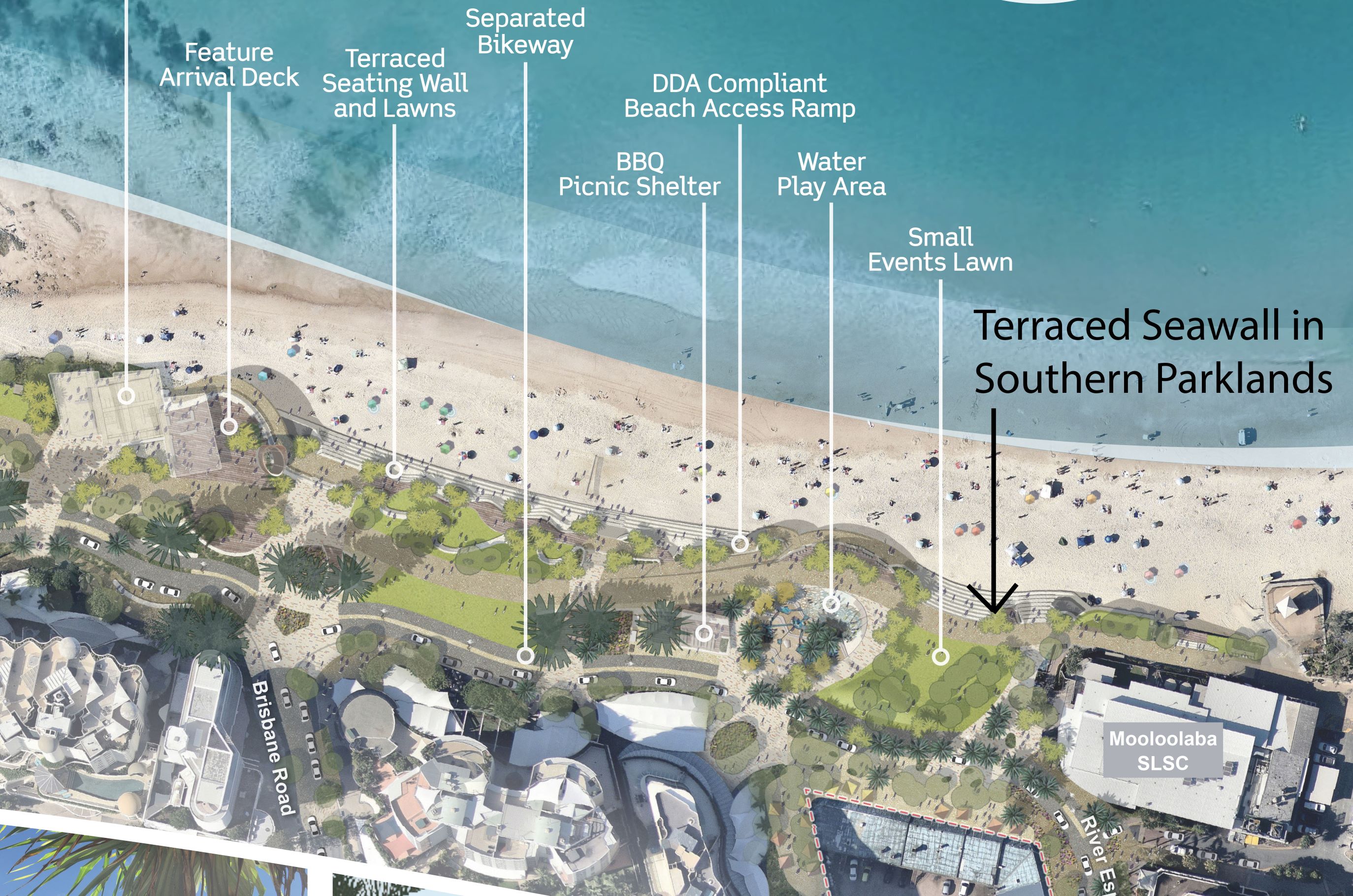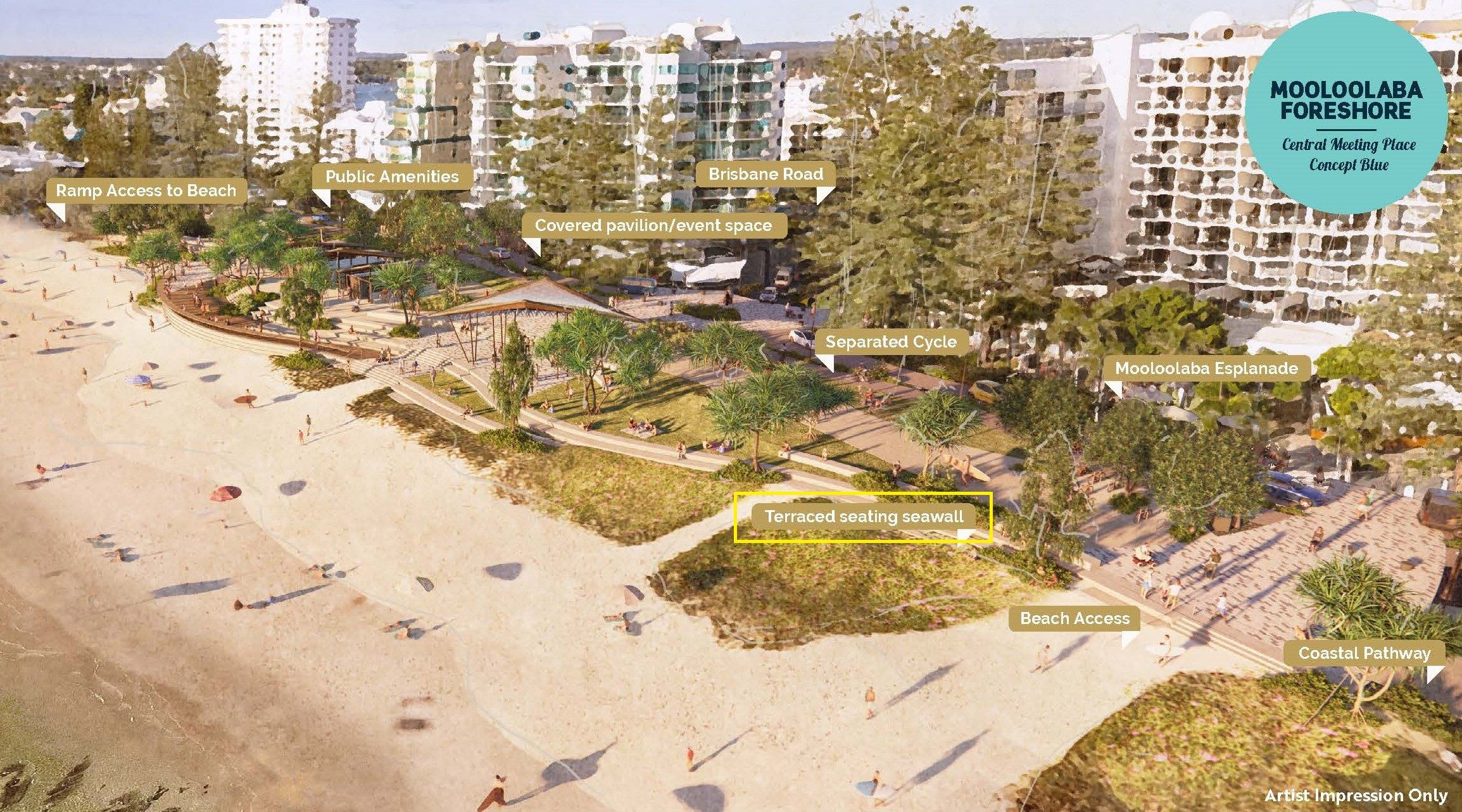Frequently asked questions
Check below for answers to our most frequently asked questions.
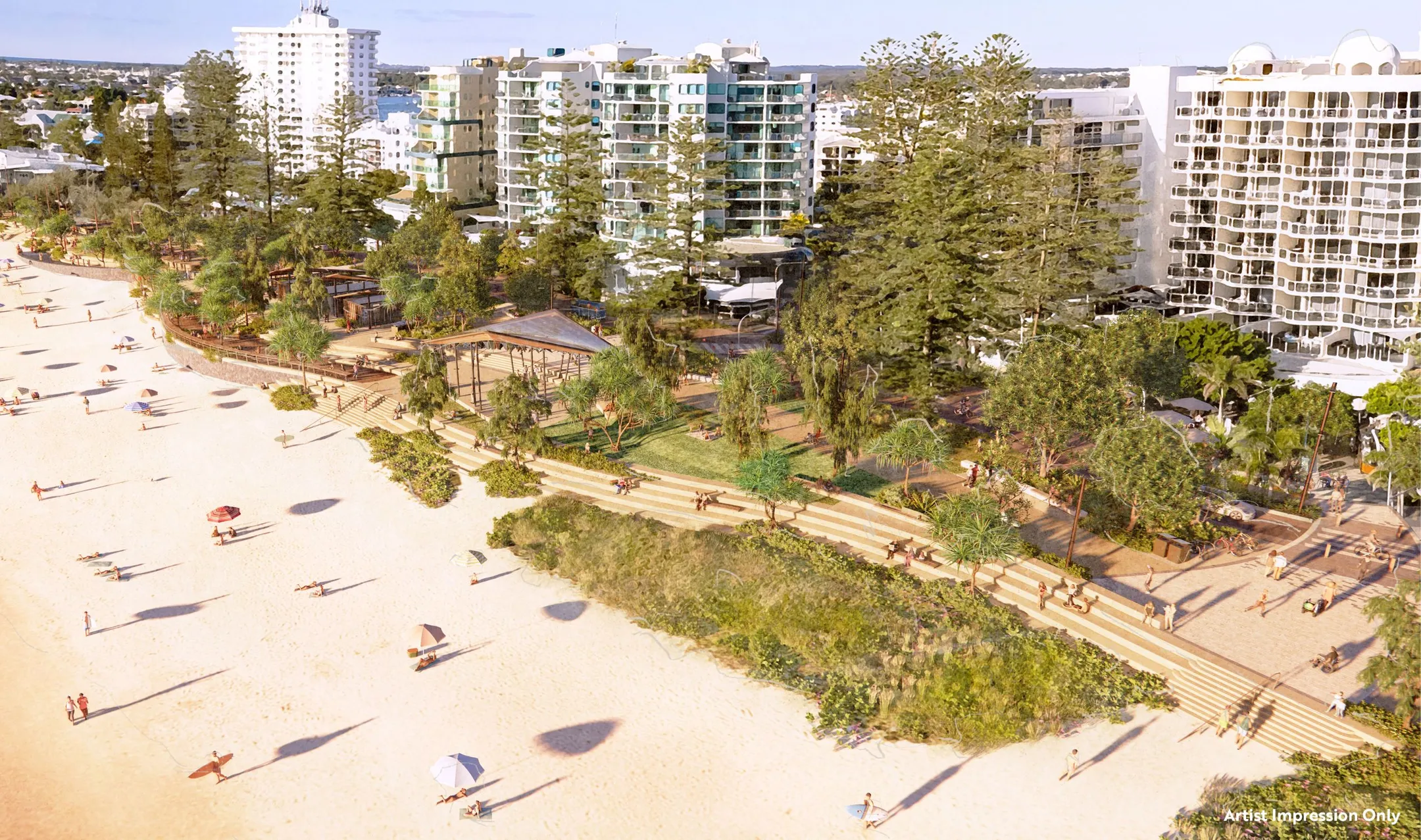
Check below for answers to our most frequently asked questions or get in touch with the team if you can’t find the answer you’re looking for.
About the project
About the project
Why is the Mooloolaba Foreshore Revitalisation Project happening?
The foreshore revitalisation project is an outcome of the 2015 Placemaking Mooloolaba Master Plan. The purpose of the Master Plan is to provide a clear, compelling and unique vision for Mooloolaba over a possible 20-year period (to 2035). More than 3,000 participants took part in the community engagement exercise for the Master Plan which received a very high level of community support (82 per cent).
The Master Plan references four areas of Mooloolaba for revitalisation namely:
- the foreshore and esplanade (this project)
- heart of Mooloolaba
- wharf precinct
- southern gateway.
How long will the foreshore’s revitalisation take?
The revitalisation of the foreshore is being undertaken in four stages.
The first stage, the Northern Parkland was opened in June 2022 and includes one hectare of revitalised parkland incorporating a raised boardwalk, viewing areas, a playground, accessible coastal pathways, undercover barbeque areas, seating and landscaping.
The second stage includes the Central Meeting Place and the Southern Parkland Seawall. Construction is expected to start June 2025 and continue throughout 2026.
Future stages include the remainder of the Southern Parkland and the Central Parkland. A timeframe, sequencing or funding for these stages have not been determined.
Refer image: Map of Mooloolaba Foreshore Revitalisation stages.
What does Stage 2 include?
Stage Two Central Meeting Place includes 6,500 square metres of beachfront parkland, new community facilities and the replacement of an existing seawall which dates back to the 1960’s.
Features include:
- new public toilets and showers (to replace the ageing Loo with a View) including facilities for people with high support needs
- enhanced beach access with an all-abilities access ramp for people using wheelchairs, prams or mobility devices
- new shaded event and meeting pavilion
- open grassed areas, and new landscaping with plants and shade trees
- variety of beach-front and shaded seating options, plus picnic areas
- an ocean viewing deck
- public artwork
- wider six metre coastal pathway (previously two to three metres)
- replacing the existing aged vertical seawall.
Why is Stage 2 taking place now?
There are two elements of Stage Two which require urgent replacement:
- The ageing Loo with a View which has served the community in the past but is now in very poor condition and does not meet community needs.
- The current seawall which was built in the 1960s and is no longer adequate to protect the foreshore for the next 50-plus years, particularly if impacted by multiple extreme weather events.
Combining the Central Meeting Place’s construction with the Southern Parkland seawall replacement’s works will deliver time and cost efficiencies for ratepayers. It will minimise the overall project’s construction duration in the longer term, thereby reducing inconvenience to local residents and businesses.
What is happening to the Loo with a View and what is replacing it?
Stage Two - Central Meeting Place includes building new public toilets and showers in the same/similar location to replace the ageing Loo with a View which has served the community in the past, but is now in very poor condition and does not meet community needs or comply with people with disability accessibility requirements.
The Loo with a View’s cantilevered deck section has now been closed to the public to ensure community safety. Following expert advice, a pedestrian barrier – which does not affect the views – has been installed to restrict access to the front of the cantilevered deck and the area underneath the deck until the old building can be demolished.
The new Central Meeting Place public toilets, showers and handwashing facilities are designed in a similar architectural style to the recently completed Northern Parkland amenities. They will be housed in a series of three ‘pods’ under one joined roof and feature a range of flexible areas including family rooms and unisex cubicles where people can use the toilets, change or shower. As well as reducing the visual impact of the building, the design allows improved access, air flow, natural light and safety and permits ocean views to be seen from The Esplanade and local businesses. It will include a best practice ‘Changing Places’ facility for people with high support needs, along with a new all-abilities ramp in this areato provide easy access to the beach.
You can see the amenities in this video (relevant images start at approximately the 1 minute 30 second mark).
Access to public toilets, showers and hand washing facilities will remain available pre, during and post Stage Two construction.
What is a Changing Places Toilet facility?
A Changing Places toilet facility allows people with high support needs to participate in all elements of community life, without having to limit their time out due to concerns about being able to access a suitable toilet.
Changing Places toilets provide:
- a height-adjustable adult-sized change table
- a constant-charging ceiling track hoist system
- a centrally located toilet
- circulation spaces
- an automatic door
- a privacy screen.
Learn more about Changing Places here: https://changingplaces.org.au/
Will there be lighting along the foreshore?
As part of Stage Two works, lighting will be included from the Central Meeting Place/ Brisbane Road area to the Surf Club.
Community safety is a consideration, as well as existing events, beach volleyball and other sporting activities.
Our region’s turtles and their hatchlings have also been considered in determining the lighting design.
Have beach sports been considered during design and construction?
Beach volleyball and other sporting activities have been considered as part of the Stage Two Design. Lighting will be included, from the Central Meeting Place/Brisbane Road area to the Surf Club. The replacement seawall’s wide terraced steps will double as spectator seating.
Council continues to work with the Volleyball organisers to ensure the club and players have accurate information at hand ahead of construction in terms of proposed temporary relocation of beach courts.
What landscaping is being done?
New plants and shade trees form an integral part of the design with open grassed areas and picnic spaces. The seawall will also be enhanced by attractive landscaping, including plants and shade trees, along with revegetation of the adjacent dunal areas.
Providing more shade and shelter was a key theme shared by our community through the extensive period of community engagement.
Construction
Construction
When will Stage 2 construction start?
Council is currently in the tendering phase and will work with the successful contractor to guide the project’s timing, how it will be constructed and sequencing.
Some early preparation construction works are expected to take place in various locations across the Stage Two project area from January 28 to May 2025. These early works will ensure a smooth transition to the major works period starting in June 2025 and continuing through 2026.
The exact timing and methodology of major works will be confirmed following the anticipated appointment of a contractor in early 2025.
Council will work closely with the successful contractor to make sure that our community and local business operators are kept well informed of construction plans.
All information about the project is accurate at the time of distribution. Project outcomes including design, works and dates may be subject to change due to circumstances beyond the Mooloolaba Foreshore Revitalisation Project team’s control.
Will the beach be closed during construction?
No. For safety reasons some areas of the beach will be temporarily fenced off during the replacement seawall’s construction, but beachgoers can be assured there will always be public access to the beach and a surf lifesaver patrol flagged area at Mooloolaba throughout construction.
Will there be access to businesses along the Mooloolaba Esplanade during construction?
Yes. Mooloolaba will remain ‘open’ and ready to welcome locals and visitors during construction. Access will remain to our community’s favourite shops, cafes, accommodation and other businesses on the Esplanade and nearby streets.
Will I still be able to park close to the beach at Mooloolaba during construction?
Yes. Parking will remain available near the beach, including at the ParkNGo Mooloolaba Central car park just 300 metres to Mooloolaba Beach and the foreshore.
To ensure community safety, some temporary changes to traffic conditions and on-street parking will be required during construction Council will work closely with the successful construction contractor to make sure that our community and local business operators are kept well informed in advance of any changed conditions.
What about people with disability parking, drop off areas and loading bays?
When construction is complete people with disability car parks, loading bays and drop off areas will remain along the foreshore as part of all stages of the Mooloolaba Foreshore Revitalisation project.
During construction these items will remain available however may be provided in different locations to ensure community safety.
How can I register for a job, or to be a supplier for Stage 2 construction?
An independent construction contractor will be engaged to construct the project. Once Council’s tender period is complete and a construction contractor is appointed, this information will be shared with our community.
Interested parties can then contact the contractor directly regarding potential employment or supply opportunities.
Parking
Parking
Will accessible parking be retained on the Mooloolaba Foreshore?
Yes. Council is committed to building inclusive communities and accessible parking bays will remain available along the foreshore as part of all completed stages of the Mooloolaba Foreshore Revitalisation.
As well as accessible parking, the foreshore parking plan will include passenger pick up/drop off facilities, short-term parking and loading zones for residents, visitors and commercial vehicles.
The community supported 2015 Placemaking Mooloolaba Master Plan included the building of the undercover parking at ParkNGo Mooloolaba Central with more than 700 public car parking spaces and 13 accessible parking bays available. The undercover parking facility is less than 300 metres to Mooloolaba Beach and the foreshore.
The ParkNGo enables the ultimate removal of a number of foreshore car parks to realise the creation of a world class foreshore destination.
When construction is complete people with disability car parks, loading bays and drop off areas will remain along the foreshore as part of all stages of the Mooloolaba Foreshore Revitalisation project.
During construction these items will remain available however may be provided in different locations to ensure community safety.
Where can I park during construction?
During Stage Two construction, parking will remain available near the beach, including at the PARKnGO Mooloolaba Central car park just 300 metres to Mooloolaba Beach and the foreshore and a short stroll to businesses on the Mooloolaba Esplanade.
From 28 January 2025, Council has provided the first four hours of parking free at the PARKnGO Mooloolaba Central.
To make it easier for car park users, those who park for less than four hours can forego the pay station and head straight to the exit. The barrier will automatically open when the parking system detects your car's licence plate.
Car park users staying longer than four hours will pay $5 per hour, capped at $20 per day.
This initiative is part of the Mooloolaba Business Activation Plan – developed as a collaboration between the Mooloolaba businesses community and Sunshine Coast Council to drive activation and business support during Stage 2 of the Foreshore Revitalisation.
The promotion will conclude when Stage Two Central Meeting Place and Southern Seawall are completed.
For more information, please visit the PARKnGO Mooloolaba Central website.
What parking changes are part of Stage Two works?
In regard to the current stage of work, Stage Two (Central Meeting Place and Southern Parkland seawall), the Beach Terrace roadway and majority of parking will be retained. Stage Two retains approximately 70 of the existing 96 Beach Terrace parking bays.
Beach Terrace will be replaced by parkland and community facilities as part of the future ‘Central Parkland’ stage. Timing and funding for this stage has not yet been determined however Council remains committed to delivering all stages of the project.
Why is Council relocating the parking from Beach Terrace as part of the overall foreshore project?
In line with the outcomes of, and level of community support for the 2015 Placemaking Mooloolaba Master Plan, Beach Terrace will be transformed to new community oceanfront parkland and facilities as part of the future Central Parkland stage of the foreshore’s revitalisation. Timing and funding for this stage has not yet been determined.
The permanent removal of the roadway and relocation of approximately 150 car parks was supported by 84 per cent of community engagement participants. The master plan also recommended building an undercover parking station to provide additional parking at Mooloolaba. Opened in December 2020, the ParkNGo Mooloolaba Central car park features over 700 public car parking spaces and 13 accessible parking bays along with free bicycle parking. The undercover parking facility is 300 metres to Mooloolaba Beach and the foreshore.
People with disability car parks, loading bays and drop off areas will remain along the foreshore as part of all completed stages of the Mooloolaba Foreshore Revitalisation project.
Read the community consultation feedback report for the Placemaking Mooloolaba Master Plan.
Coastal modelling process
Coastal modelling process
The present seawall is approximately 60 years old. Coastal modelling and engineering assessments have determined the existing seawall is not of a suitable height or depth to withstand present day extreme cyclone events, nor future major storm events and climate change.
The proposed terraced seawall provides a preferred solution at Mooloolaba, as it maximises public amenity, connection between the beach, foreshore, surf club and businesses and allows access for all.
Vertical seawalls occupy the smallest footprint, but present day regulations mean that balustrading would be required where the potential fall height exceeds one metre. With or without the balustrade, this creates a disconnection between the foreshore land and the beach.
The following questions outline the coastal modelling process for the new seawall.
What was the Coastal modelling process?
The proposed terraced seawall design was informed by rigorous coastal studies, computer modelling, desktop calculations, structural engineering and peer review reports completed by industry-leading coastal engineering experts, in conjunction with Council staff and the outcomes of previous community engagement activities.
Coastal modelling studies started at concept and proceeded throughout the design process including the 60 per cent and 90 per cent detailed design stages.
These reports are working documents that informed the design process at that time, with some information now superseded. Findings in these reports have been used to further refine the final design.
To view the detailed expert reports in full, please refer to links below.
Will the new seawall cause more erosion during a significant storm event?
The coastal modelling report states that:
Under the existing seawall design, the modelling shows there is the potential for over 200 m3/m of sand to be lost from the beach in a significant storm (1 per cent Annual Exceedance Probability, AEP), with almost all of the subaerial beach above 0m AHD (Australian Height Datum) lost during the design event. This occurs for both the existing and proposed structures. The proposed design typically has a wider footprint than the existing seawall and reduces the amount of available backshore sand which would typically be eroded in a storm event. This results in a reduced erosion volume, however typically deeper scour levels adjacent to the structure.
The modelling was performed in targeted locations (Sections 1, 2, 3) which are the three most protruding sections of the proposed new seawall, to test three different seawall profiles. While normal practice, this is not a balanced assessment as it focusses on the areas of greatest impacts and areas where the seawall retreats (moves landward) the impacts are expected to be less.
The post-storm beach profile after an extreme event will be eroded, in both existing and new seawall modelled scenarios. In terms of remaining beach width, the existing seawall scenario typically has a slightly wider beach (at 0m AHD) than the new seawall design after an extreme event. However, at the base of the existing wall this erosion would expose the introduced protective rock layer reducing usable beach width as occurred during Tropical Cyclone Oswald in 2013.
It is also expected (based on historical observations) when a significant amount of sand is eroded above the 0m AHD (i.e. mean water level), this sand will move just offshore into a storm bar during the event and naturally migrate back to the beach after the event.
Once the project is complete, a beach nourishment program will further replenish eroded sand in the future management of this high-profile beach, especially after storm events.
Was a physical model developed?
Standard industry practice is to use coastal modelling software to test extreme storm event situations in a conservative, risk averse nature to inform the seawall design.
Physical models can be used to further qualify over-topping and wave force calculations when needed.
A physical model was not implemented for the following reasons:
- A conservative approach was maintained by testing back-to-back extreme storm events in the coastal modelling software to determine the seawall design.
- Extensive structural engineering design with factors of safety have sufficiently informed the seawall design.
- Due to the adaptability of the terrace seawall the height can be increased beyond the applied 50-year design range with additional terraces in the future.
- Physical models do not measure beach erosion, as sand cannot be reduced to a suitable scale for modelling purposes.
What is a physical model?
A physical model is a scaled-down replica of a seawall structure used in laboratory experiments to study its performance under different wave conditions.
What is the level of confidence in the seawall design?
The seawall has been modelled and designed by specialist qualified coastal and structural engineers as part of the project design team, which are Registered Professional Engineers of Queensland.
The coastal engineering design has been peer reviewed by an Australian and international expert with a Master of Engineering Science degree, majoring in Coastal Engineering and Physical Oceanography. They have more than 30 years of Australian and international experience with structures of this type.
Highly qualified coastal and structural engineers were engaged by Council including:
- JBP Scientists and Engineers
- Water Research Laboratory of the School of Civil and Environmental Engineering at the University of New South Wales
- Barlow Shelley Consulting Engineers.
The reports contain standard limitations for coastal engineering, which are managed through factors of safety, as per all engineered buildings and infrastructure.
The beach erosion modelling was carried out at the 60 per cent Detailed Design (DD) and has been continually fine-tuned. At the 90 per cent DD no further assessment on beach erosion modelling was required. Wave overtopping was revisited after the peer review and seawall design updates.
The seawall has variable cross sections along the shore, which includes a curved platform and terraced revetments. Throughout the design and subsequent review processes, a conservative approach was applied to the coastal, geotechnical and structural engineering of the seawall. This will provide a contemporary engineering level of protection to the physical foreshore assets during major storm and extreme wave events.
It should be noted that the peer review concluded that:
A coastal modelling report was undertaken by JBP (Mooloolaba Central Meeting Precinct: Coastal modelling, Updated Final Report, April 2024). This report underwent multiple revisions (eight versions) due to peer review by WRL, collation of components and ongoing revisions. This report is of a good professional standard.
The report consisted of four components:
- Extreme wave study
- Extreme beach profile morphological study (Erosion XBEACH modelling)
- Extreme wave overtopping study (most comprehensive desktop EurOtop tool available with JBP work peer reviewed)
- Wave action study.
This resulted in consistent outputs with other east coast Australian beaches.
The replacement seawall has been approved by State Government approval agency SARA including referral departments.
What were the design considerations?
A range of information was considered as part of the seawall’s design process including but not limited to:
Outcomes of the previous plans, strategies and community engagement activities including:
- 2014 Shoreline Erosion Management Plan
- 2015 Placemaking Mooloolaba Master Plan
- 2021 Council’s Coastal Hazard Adaptation Strategy and
- 2022 Stage Two Community Engagement
(all documents are available under the ‘Community engagement’ tab).
Coastal management strategies, processes, hazards and options for Mooloolaba’s foreshore including:
- Coastal processes – Waves, tides, ocean currents, ongoing and future sea level rise
- Coastal hazards – Erosion, shoreline recession, ongoing and future sea level rise, inundation (especially from wave run-up and overtopping)
- Industry best practice mitigation and management strategies, including various types of seawalls.
Coastal engineering, technical reports and data:
- Recorded water level data, extreme storm tide levels and tidal planes
- Historic wave data from Brisbane and Mooloolaba wave buoys
- Geotechnical investigations, Sand sampling and analysis
- Multiple surveyed and observed sand levels from (1971 to present day) from the seawall to 15 metre water depth.
- Beach and parkland usage
- Access to the beach, including all abilities, life saver and lifeguard access.
Modelling of the data and observations (from 1976 onwards) including:
- Extreme nearshore wave study
- Extreme beach profile morphological study
- Extreme wave overtopping study
- Wave action study (forces on the structure).
Mooloolaba Beach and surrounds usage:
- Community usage of beach and parklands
- Business activities
- Events
- Lifeguard and emergency service functions
- Below and above ground infrastructure
- Operational and maintenance requirements.
Seawall replacement
Seawall replacement
What will it look like?
The replacement seawall will see the current vertical rock-pitched seawall replaced with a light-coloured concrete seawall which predominately features wide terraced steps that will double as community seating. The design connects our community from ‘beach to business’ by reducing physical and visual barriers and includes enhanced access with an all-abilities access ramp for people using wheelchairs, prams or mobility devices.
The replacement seawall will also include an ocean viewing deck and attractive landscaping, including areas with seats and shade trees, along with revegetation of the adjacent dunal areas.
The terraced steps/seats of the seawall will be the perfect place to watch the waves or attend exciting and future major events in Mooloolaba such as New Year’s Eve celebrations, festivals, the ANZAC Day service and beach sports like volleyball and rugby.
Replacing the seawall now is the first critical step required to protect community infrastructure like our parklands, paths, roads and underground services (such as power, telecommunications and water supply) from climate change impacts.
Why replace the existing seawall now?
Replacing the seawall now will better protect the community parklands, paths, roads and underground services (such as power, telecommunications and water supply) from climate change impacts as well as provide improved access from the foreshore to the beach.
Combining the Central Meeting Place and Southern Parkland seawall construction as Stage Two is expected to deliver significant cost and time efficiencies for our community as part of the foreshore’s overall revitalisation.
The seawall is the first critical step required to protect community infrastructure and allow the revitalisation of ageing community facilities and assets.
A range of expert and independent assessments has confirmed that the existing seawall (built in the 1960’s) is not of a suitable height, design or condition to withstand future major storm events.
Council’s 2021 Coastal Hazard Adaptation Strategy and Shoreline Erosion Management Plan indicate that areas of the foreshore, transport infrastructure and underground services are at significant risk of rising sea levels, natural disasters, coastal erosion, storm surges, coastal inundation and cyclones.
In 2013 the remnants of Ex-Tropical Cyclone Oswald caused significant damage to our region’s coastline due to the impacts of high rainfall, cyclonic winds, large waves and extreme sea levels. At Mooloolaba, significant coastal erosion was experienced impacting the existing vertical seawall, lifeguard tower and access to the Mooloolaba Surf Lifesaving Club.
Undermining of the seawall due to significant sand loss meant that emergency works were required to stabilise the site, reinstate the lifeguard tower and provide public and emergency services access back to the beach.
It is predicted that extreme weather events will become more frequent in our region. Based on future climate change the existing seawall won't suitably protect the foreshore for the next 50-plus years, particularly if impacted by multiple extreme weather events.
Refer to image: Coastal damage and sand scouring (erosion) in areas of existing seawall caused by ex-Tropical Cyclone Oswald 2013.
Refer to image: 1968 Mooloolaba Beach Aerial showing existing seawall, and images from ex-TC Oswald from 2013.
Will replacing the existing seawall mean there is less useable beach area?
In everyday conditions there will be a similar amount of beach area for our community to enjoy.
Of the total Mooloolaba Beach (Alexandra Headland to The Spit), the Stage Two project will result in a reduction of 171sqm usable beach space which is roughly equivalent to half a basketball court. This reduction is spread across a new curved 290 metre seawall, meaning the impact is minimal and distributed.
The new seawall, with its sinuous curved design, will result in variations in usable beach area. In some locations the new seawall curves out and at other places it curves in. This small adjustment allows us to provide a public space that is compliant with the Disability Discrimination Act (DDA), including a beach ramp.
An additional 864sqm (equivalent to two full basketball courts) of seating terraces and landscaped areas will be delivered as part of Stage Two.
Like all coastal areas, Mooloolaba Beach will continue to be subject to the impacts of weather conditions and tidal sand movements.
Will the seawall have any impact on beach sand levels or dunes?
Expert assessment has shown sand levels in this area of Mooloolaba Beach are subject to the normal changeability of weather conditions.
The replacement seawall is expected to have a negligible impact on sand levels under normal weather conditions. As is currently the case in times of extreme weather, some sand loss would be expected, followed by beach renourishment.
Dunal revegetation will form part of Stage Two works. Council will continue to monitor beach conditions during and post construction.
How far away will the replacement seawall foundations be from the high tide line?
Based on sand survey levels (since 2016), the furthest part of the replacement seawall foundations will be approximately 23 metres away from the average king tide (Highest Astronomical Tide, HAT).
The closest king tide recorded since 2016 would be 11m away.
Its foundations will be buried deep under the sand to ensure it provides adequate protection for Mooloolaba and fulfils its design life of approximately 50 years.
Refer to images: Graphical representation of highest astronomical tide locations based on 2016-2023 sand survey data.
How does the design benefit this location?
Different environments require different seawall treatments. For Stage Two, the predominate use of a terraced seawall is considered the best design and outcome for the community
When compared to the existing vertical seawall the new seawall benefits are:
- More inclusive - enhanced beach access including an all-abilities access ramp for people using wheelchairs, prams or mobility devices
- More functional - multi-functional terraces increase stair access and seating opportunities
- Safer - reduced potential fall hazard
- Greater climate resilience - improved wave energy dissipation and protection from future climate conditions
- Improved access and connectivity - connects ‘beach to business’ by reducing physical and visual barriers (i.e. handrails and barriers) and improving amenity
Building another vertical seawall in the same location would mean a physical and visual barrier would exist between the beach and the foreshore, complete with a one-metre-high fence and railings.
Unlike a terraced seawall it would not allow for seating areas or landscaping opportunities (including shade trees and plants for greening the foreshore) or fulfill the accessibility expectations of our community or Council.
Some vertical elements will be required to allow ramp access to the beach and a viewing deck to enjoy the beach and ocean views.
Refer to images: See 'before and after' images showing existing seawall and replacement terraced seawall and parkland.
Where does it sit?
The following images show the existing and future seawall extents overlaid on both the existing aerial image and the new final design which allows our community to enjoy the beach and ocean front parkland. The sinuous curved design of the seawall responds to the natural ‘wave’ environment and originates from the local Kabi Kabi name for Mooloolaba ‘mulu’ meaning snapper fish, or 'mullu' meaning red-bellied black snake.
Of the total Mooloolaba Beach (Alexandra Headland to The Spit), the Stage Two project reduces the useable beach space by 171sqm (less than half a basketball court). An additional 864sqm (equivalent to two full basketball courts) of seating terraces and landscaped areas will be delivered as part of Stage Two via the terraced seawall.
Download the images for a closer look.
How did Council develop the design?
Replacing the seawall at the Mooloolaba foreshore formed part of the 2015 Mooloolaba Placemaking Master Plan and was identified in the 2021 Council’s Coastal Hazard Adaptation Strategy and Shoreline Erosion Management Plan.
It has been modelled and designed by a qualified coastal engineer and structural engineer as part of the project’s design team, both Registered Professional Engineers of Queensland.
The coastal engineering design has been peer reviewed by an Australian and International expert with a Master of Engineering Science degree, majoring in Coastal Engineering and Physical Oceanography with over 30 years of experience.
The replacement seawall has been approved by State Government approval agency SARA including referral departments.
As part of the seawall design process a range of information is considered including:
- Astronomical tides, extreme storm tide levels, and tidal planes
- Waves including historic wave data, wave buoy analysis, design wave data, wind-driven waves, and wave overtopping
- Sand levels and beach variability
- Beach and parkland usage
- Access to the beach, including all abilities access
Why can’t the seawall be buried under parkland or closer to the buildings?
Seawalls provide erosion protection. They are designed to protect community infrastructure and services (parklands, paths, roads and underground services such as power, telecommunications and water supply) from the impacts of severe weather events and climate change.
If community infrastructure and services were located on the ocean side of the seawall, they would be vulnerable to erosion during severe weather events. Based on current climate change predictions the community infrastructure and services would eventually be lost to the elements. This would cause significant economic, environmental and social impacts to Mooloolaba, particularly for businesses, residents and tourism.
The seawall is considered our ‘last line of defence’ and the alignment of the replacement seawall has been carefully considered to protect our community’s coastal infrastructure in this location. In other locations different seawall design treatments may be considered.
Funding
Funding
How is the replacement seawall being funded?
The replacement of the seawall is funded by Council's Capital Works Program and the Federal Government.
In June 2023, it was announced the project would receive $7.95 million in funding from the Federal Government’s National Emergency Management Agency Disaster Ready Fund toward replacing the seawall.
This significant financial contribution will minimise the cost to ratepayers while providing enhanced protection for Mooloolaba.
How is Stage 2 Central Meeting Place being funded?
Stage 2 is currently funded by Council’s Capital Works Program and the Australian and Queensland governments.
In January 2025, it was announced the Central Meeting Place would receive $13.3 million in funding from the Australian and Queensland governments, as part of the $285.8 million SEQ Liveability Fund.
The SEQ Liveability Fund is one of 29 commitments being delivered under the $1.8 billion SEQ City Deal, a partnership between the Australian and Queensland governments and the Council of Mayors to generate long-lasting benefits for the fast-growing region.
The Mooloolaba Esplanade roadworks and congestion improvements (early works) received $400,000 by the Australian Government’s Local Roads and Community Infrastructure Program.
Council will continue to seek additional funding opportunities for the project throughout the life of the foreshore revitalisation project.
Business support
Business support
What support is being provided to local business?
Since February 2024, Council has been working with the newly established Mooloolaba Business Activation Group and Mooloolaba Stakeholder Interest Group.
Council remains committed to working with the Mooloolaba business community to develop a program of activities and initiatives pre, during and post construction.
The Business Activation Group has been working with specialist place strategy and activation company, Reactivate Consulting, on delivering a Business Activation Plan.
The Plan aims to activate Mooloolaba and encourage businesses to continue to attract locals and visitors before, during and after Stage 2’s construction, as well as share the future vision for this regionally significant project.
Please refer to our Business Support page for more information.
How can I better prepare my business for construction?
Council understands that construction projects may have some impact on local business and residents, which is why we have prepared a guide as one tool to help businesses plan and prepare in advance of construction starting.
Download the business continuity guide for more information and helpful hints.
Has Council considered the economic impact of the project?
Yes. The Mooloolaba Foreshore Revitalisation is expected to deliver major positive economic and social outcomes to the area by improving local amenity, increasing visitation (locals and visitors) and providing enhanced protection for Mooloolaba into the future.
The project is expected to elevate Mooloolaba in the regional employment hierarchy during and post construction; support the ongoing activity levels required to maintain the profitability of businesses and landowners in the longer term; and improve the attractiveness of the precinct as a place to do business.
Tourism and hospitality are key industries and major contributors to Sunshine Coast’s economy. The development of an improved tourism offer has the potential to attract new visitation as well as extend the length of trip and tourism expenditure captured in the region. This will be particularly relevant with the future Brisbane 2032 Olympic and Paralympic Games given the Sunshine Coast is a proud co-host city and home to 4 key venues and 9 proposed Olympic and Paralympic events.
Community engagement
Community engagement
How was the community involved in shaping the design for the foreshore’s revitalisation?
Our community has been extensively engaged on a range of Mooloolaba projects starting in 2012 with the development of the Placemaking Mooloolaba master plan.
Since then, our community has helped inform the Mooloolaba Foreshore Revitalisation project via a range of projects all of which underwent significant community engagement including:
- 2014 Shoreline Erosion Management Plan (SEMP)
- 2015 Placemaking Mooloolaba master plan
- 2019 Mooloolaba Foreshore Detailed Design release
- 2021 Coastal Hazard Adaptation Strategy (CHAS)
- 2022 Central Meeting Place engagement as part of Stage Two
2022 Central Meeting Place Community Engagement Have Your Say webpage and 2022 Central Meeting Place Community Engagement Report - 2024 Business Activation Group and Community Stakeholder Interest Group formed
Council has met with a range of key stakeholders including local community and businesses groups on numerous occasions to discuss the project.
What is the history of community engagement for the foreshore revitalisation project?
2012-15 – Placemaking Mooloolaba master plan
The Master Plan which incorporates the Mooloolaba Foreshore Revitalisation project has been subject to extensive community engagement since its initial development. The Master Plan shows seawalls in all stages of the project – the Northern Parkland (now complete), Central Parkland, Central Meeting Place and Southern Parkland.
More than 3,000 participants took part in the community engagement exercise for the Master Plan. This established a clear understanding of core community values, as well as needs and aspirations and helped to generate the vision, principles and strategies of the plan. The Master Plan received a very high level of community support (82 per cent).
2019 –Detailed Design release
The 2019 Mooloolaba Foreshore Revitalisation project detailed design release, which evolved from the Master Plan, included full media coverage, a launch event, pop up sessions and a street walk where Council handed out project information. This project information release clearly showed the terraced seawall in the southern parklands.
Refer image: 2019 Mooloolaba Foreshore Detailed Design.
2021 – Coastal Hazard Adaptation Strategy
Extensive community engagement was undertaken in the lead up to Council’s 2021 Coastal Hazard Adaptation Strategy. That strategy, together with the Shoreline Erosion Management Plan, signified that areas of Mooloolaba’s foreshore public land, transport infrastructure, and underground services are at significant risk of rising sea levels, cyclones, coastal erosion, storm surges and coastal inundation.
2022 to 2023– Central Meeting Place endorsed
As a result of extensive community engagement between April and October 2022, 75 per cent of the public supported a new design that included a terraced seawall, which was approved by Council in January 2023 at its Ordinary Meeting.
The community stated a clear preference for improved inclusion and accessibility. The new seawall will incorporate a new easy-access ramp to the beach for everyone that is disability compliant, the first of its kind on the Sunshine Coast.
Stage Two has been extended from the Central Meeting Place to the Mooloolaba Surf Lifesaving Club to include the Southern Parkland seawall section. Replacing this section of seawall as part of the Stage Two works will deliver significant cost and time efficiencies as part of the foreshore’s overall revitalisation.
Design continuity will also provide optimal amenity and enhanced protection for Mooloolaba.
Learn about the extensive community engagement on our Have your say site.
2024 – Council Ordinary Meeting
At Council’s Ordinary Meeting on May 30, 2024, the project team provided Councillors and our community with a further update on the project, which was endorsed last year (January 25, 2023).
This update included the community engagement history, key project drivers and the design and delivery of the project, specifically around Stage Two Central Meeting Place and Southern Seawall.
The new Council accepted the recommendations in the report and approved the design, the construction timing for Stage Two and the finalisation of the Draft Business Activation Plan to begin implementation within the 2024-25 financial year.
2024 - Community Reference Groups
To assist with sharing two-way information, insights and ideas about the endorsed project, Council has established two community reference groups; a Community Stakeholder Interest Group and a Business Activation Group.
These groups remain active and have been working with Council since February 2024.
The Business Activation Group has been working with specialist place strategy and activation company, Reactivate Consulting, on developing and delivering a Business Activation Plan.
The Plan is a proactive initiative by Council and aims to activate Mooloolaba and encourage businesses to continue to attract locals and visitors before, during and after Stage Two’s construction.
Part of the Plan will feature an events calendar designed to highlight the region’s world-class natural assets and award-winning seafood, hospitality, retail and tourism offerings, keeping Mooloolaba switched on all year and throughout construction.
More information about the stakeholder groups can be found on the Expression of Interest website.
Award recognition
Award recognition
What awards has the project won?
Stage 1 of the foreshore revitalisation project, the $16 million Northern Parkland was crowned Project of the Year and also took out the $10 million to $20 million projects category at the 2022 Institute of Public Works Engineering Australasia Queensland and Northern Territory (IPWEA) 2022 Excellence Awards..
The hectare of multi-level beachfront parkland, complete with a 200-metre accessible boardwalk, viewing platforms, state-of-the-art playground, renewed seawall, public amenities, and community infrastructure is attracting thousands of additional visitors to the Mooloolaba foreshore and injecting extra expenditure into the local economy each year.
The coveted awards recognise outstanding community and economic contribution through exceptional project planning, stakeholder engagement, innovation, sustainability and environmental management.
Stage 1 Northern Parkland has also received the Green Space Urban Award by the Australian Institute of Horticulture Inc (AIH), which recognises environmental responsibility and ‘greening’ the built landscape.
The national recognition enhances community pride while also positioning our region as an environmental unique, liveable, and resilient regional city.
Contact us
Contact us
The project team is committed to keeping the community informed throughout all stages of the project.
Community members can email the project team at [email protected]
Keep up to date on the Mooloolaba Foreshore Revitalisation Project as it progresses by subscribing for emailed updates.

Graphical representation of highest astronomical tide locations based on 2016-2023 sand survey data
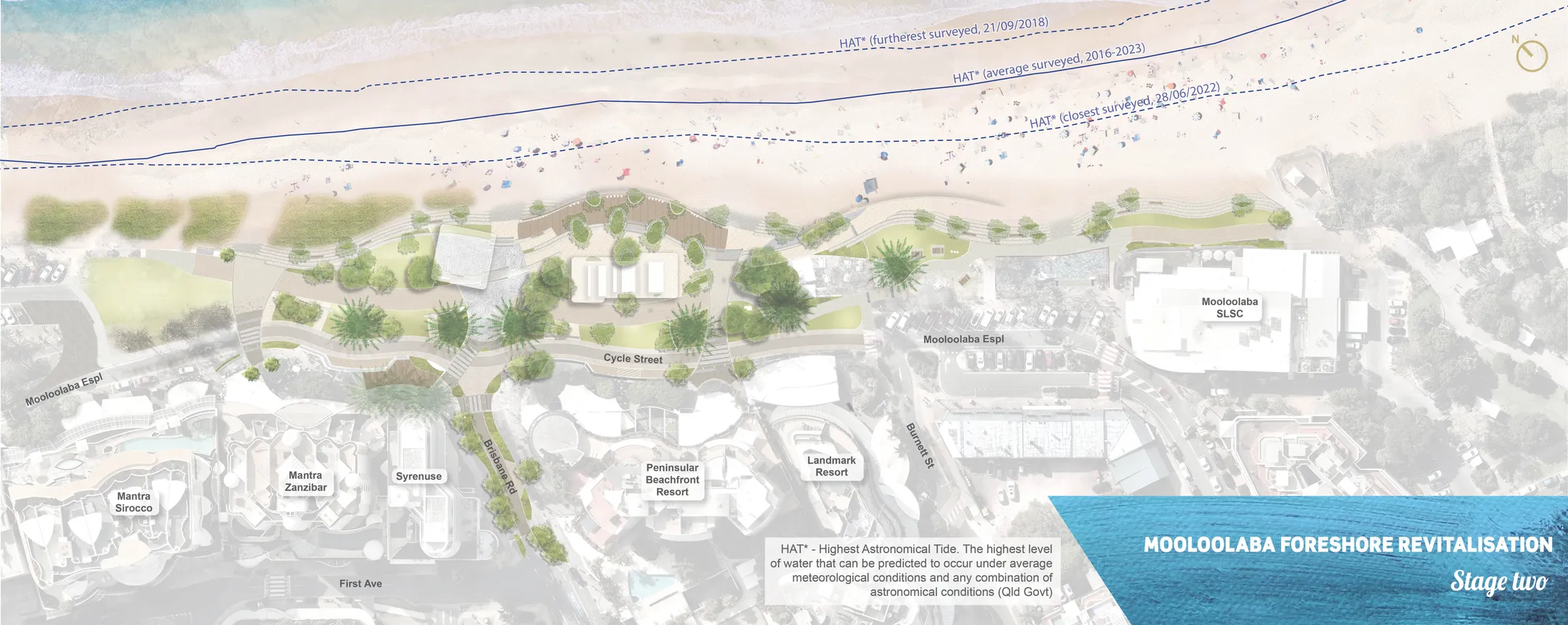
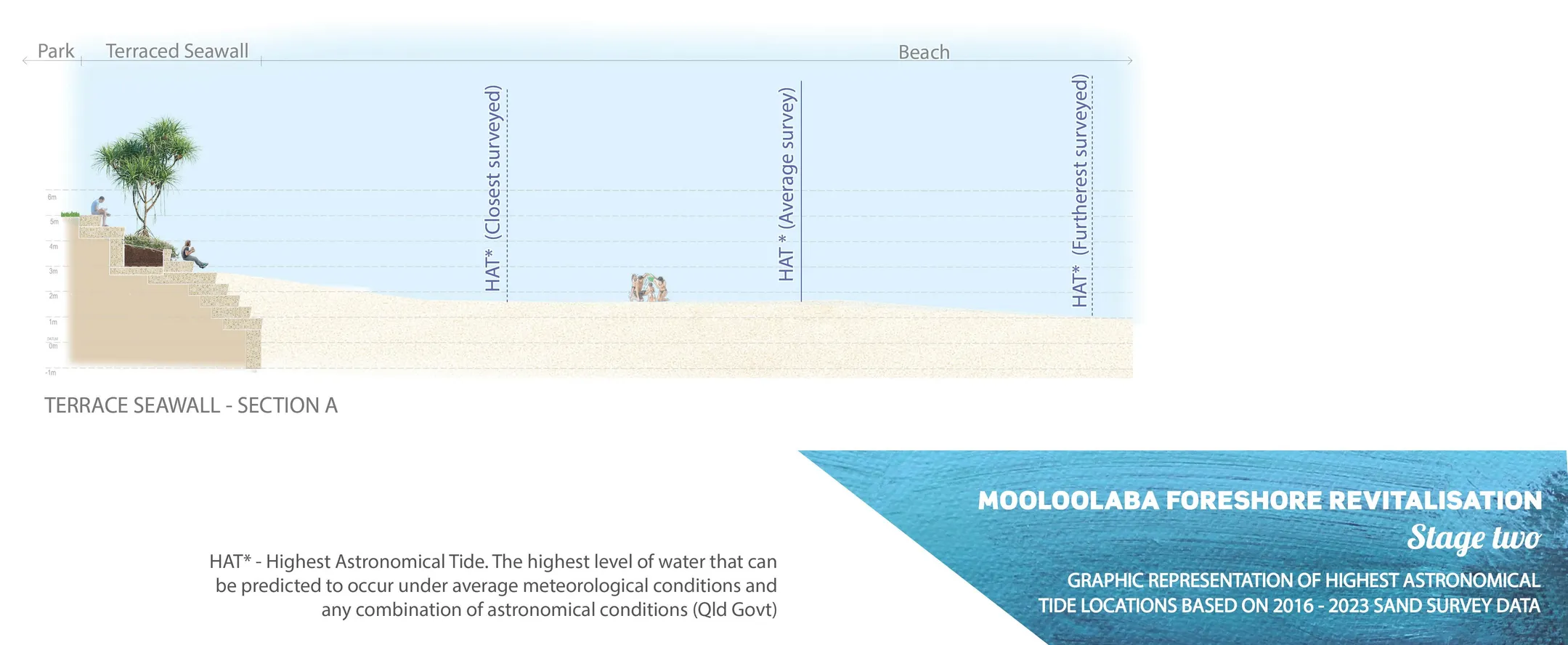
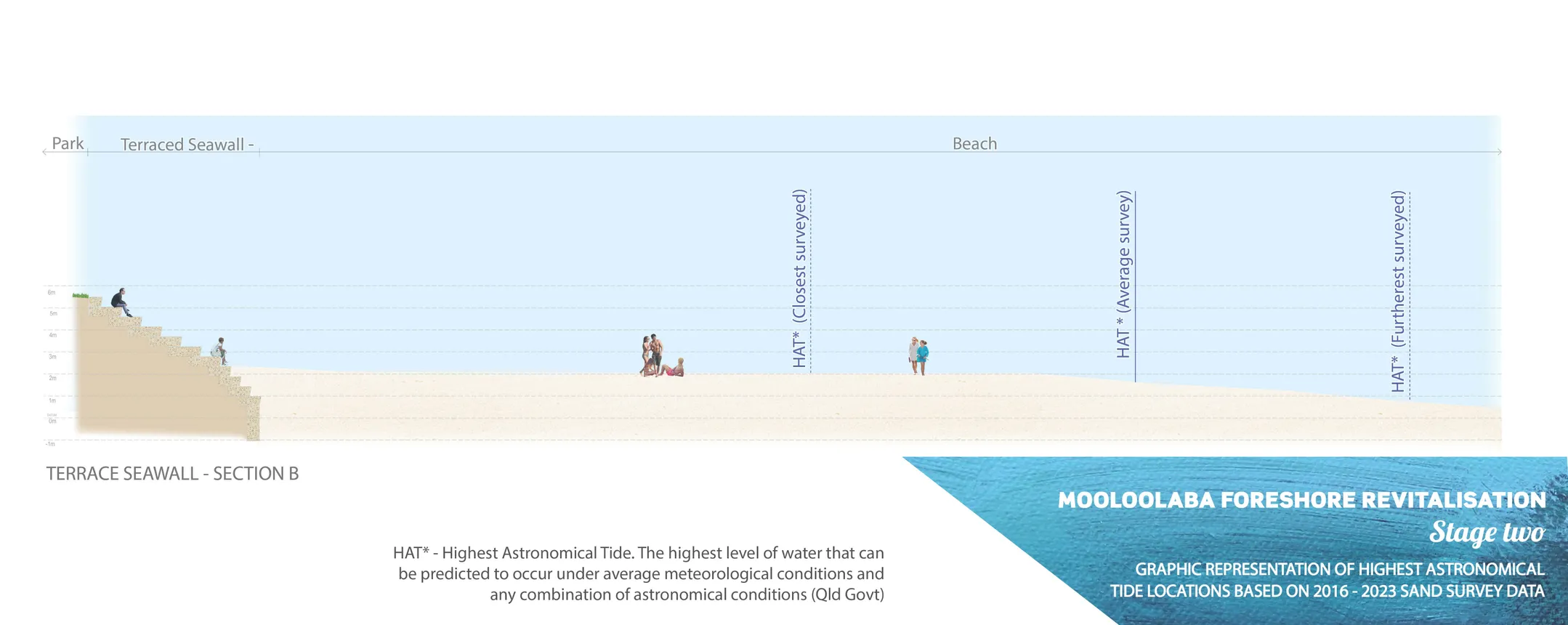

Coastal damage and sand scouring (erosion) in areas of existing seawall caused by ex-Tropical Cyclone Oswald 2013.
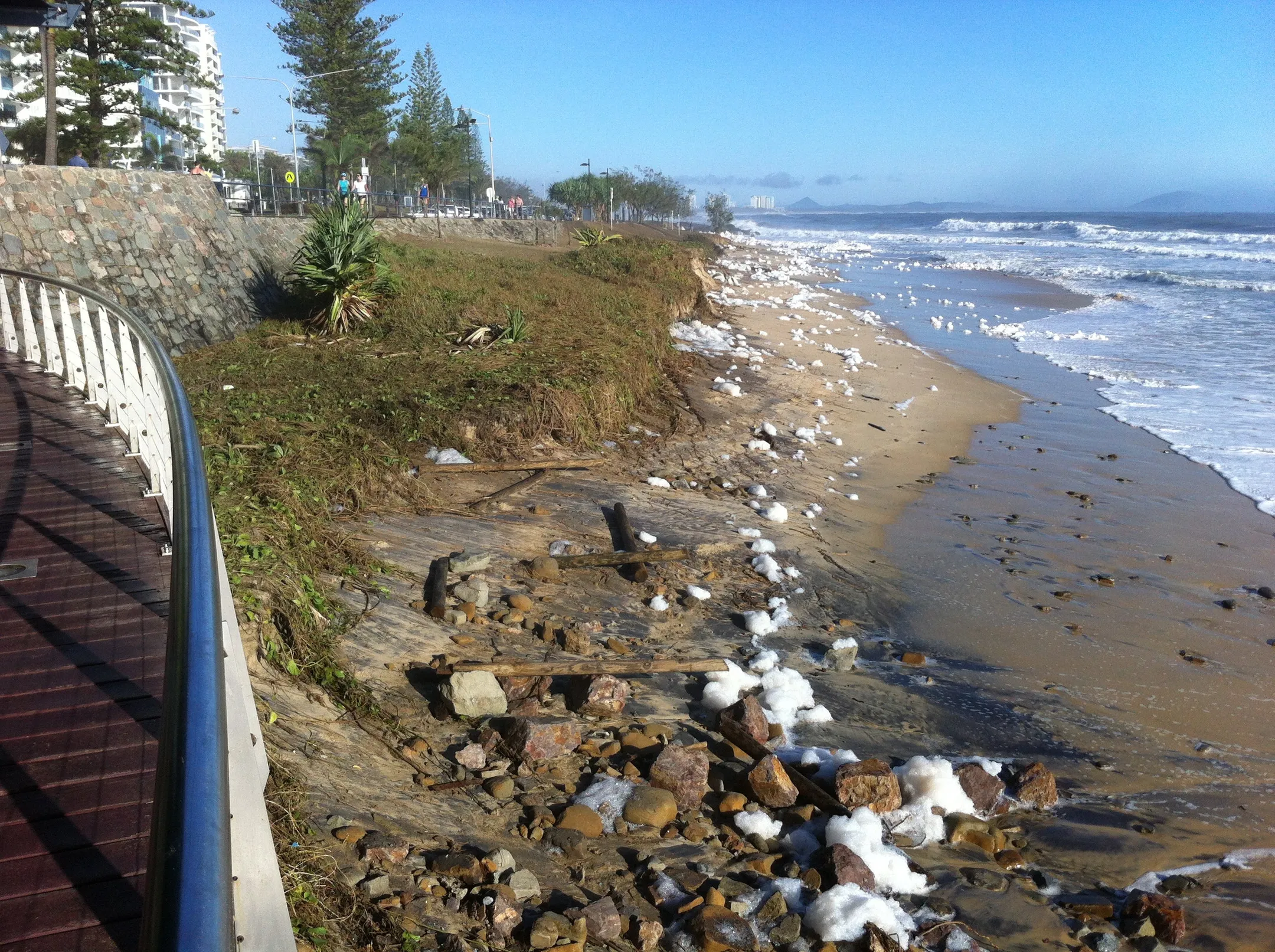
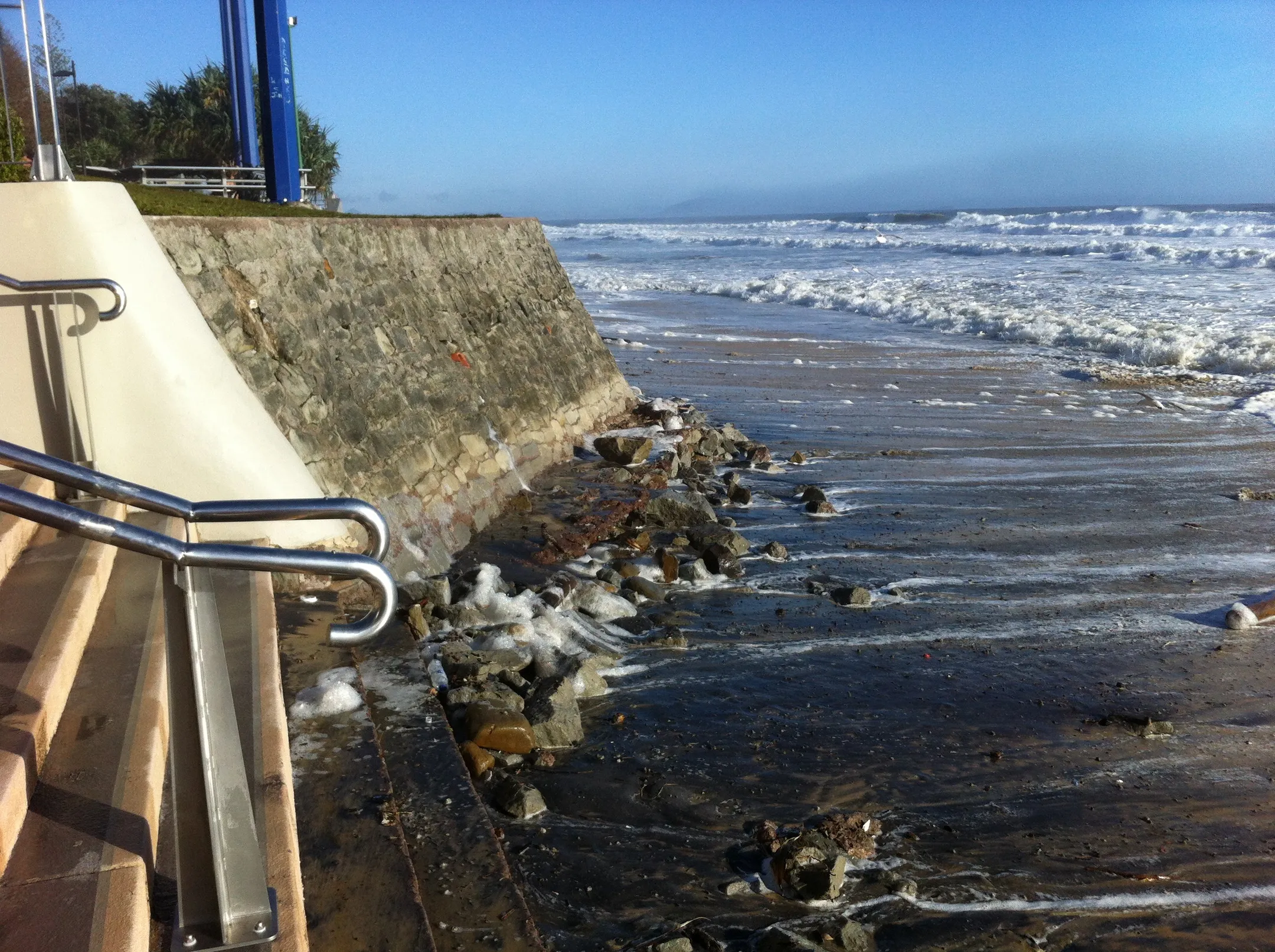
Central Meeting Place area showing existing seawall on left, with graphical representation of design of the replacement terraced seawall and parkland on right.
